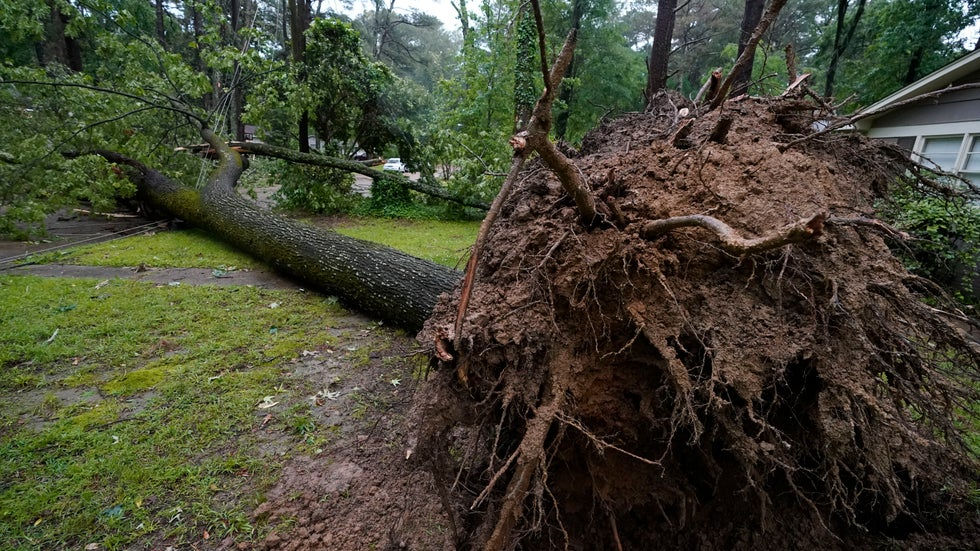Hurricane Helene’s Impact on Georgia Trees: What You Need to Know
- The Tree Experts

- Oct 9, 2024
- 4 min read
Updated: Nov 1, 2024

Late Thursday night, Hurricane Helene roared ashore in Florida as a powerful Category 4 storm, bringing with it destructive winds of up to 140 mph. The hurricane barreled inland through Georgia, North Carolina, and Tennessee as a category 1 hurricane bringing 75-80 mph gusts and winds. Millions are still without power as rescue teams and first responders race to assist survivors and provide relief to the hardest-hit areas. The storm’s aftermath highlights not only the widespread damage to homes and infrastructure but also the strain placed on the region’s trees. High winds and prolonged rainfall put immense pressure on tree limbs and branches, testing their strength and often causing unexpected failures that can lead to further damage. This serves as a reminder of how vital it is to prepare your trees for such extreme weather events.

Heavy Storms Test Tree Limbs and Branches
While Atlanta rarely experiences direct hits from hurricanes, nearby storms in the Atlantic Ocean and Gulf of Mexico often push strong winds and heavy rain into the area. These tropical storms can last for hours or even days, exposing our trees to intense loading forces and prolonged wet conditions. Without proper preparation, these factors can lead to unpredictable tree failure and costly damage to homes and properties.
One of the most common forms of tree failure during a storm occurs when poorly connected limbs and branches break under pressure. When limbs grow at sharp angles or develop decay along their axes, they are far more likely to snap in heavy winds or from the accumulation of rainwater. This is particularly true for tree species such as maples and pears, which are notorious for weak branch attachments as they mature.
When storms strike, limbs under pressure may exceed their compressive strength, causing the limb to fail at its connection point. These failures can lead to dangerous situations, especially if the limb is large or near your home. Dead or weakened branches should be removed before storm season to avoid these risks.

The Strength of Roots Under Pressure
Wind doesn’t just affect branches—it can also test the strength of a tree’s roots. Sustained winds and sudden wind shears place immense pressure on a tree’s root system, which has to transfer all the loading forces to the soil. If the base of the tree is weak or decayed, it may snap and fall. Unfortunately, many of the issues at a tree’s base are invisible until the tree fails.
In addition, Georgia's shallow clay soil becomes saturated during heavy rain, over-lubricating the ground. Trees with shallow or weak root systems cannot stand firm in slippery, over-saturated soil and may be uprooted by strong winds. Internal decay at the tree's base or roots exacerbates the risk of whole-tree failure.
Why Some Trees Bend and Others Break
During a storm, you might notice that some trees bend and sway while others snap. Interestingly, bending and swaying is a survival mechanism for trees. A tree that bends during strong winds actually reduces the net power of the storm by lessening its profile against the wind. Leaves and twigs, too, bend and twist to minimize the wind's impact, creating a cylindrical shape that makes them more aerodynamic.
By swaying in different directions, a tree’s limbs break up the harmonic effect of the wind, slowing its speed and reducing damage. However, trees that are unable to sway—due to poor health, heavy rain accumulation, or weak root systems—are more likely to break.

What You Can Do to Prepare
As hurricane season intensifies, now is the perfect time to inspect your trees. Dead limbs are typically the first parts of a tree to fail in a storm. Removing these limbs now will prevent the dead wood’s weakness from being exploited by high winds. In addition, a professional tree inspector can assess your trees for poorly attached branches or decay that may not be visible to the untrained eye.
Pruning young limbs is another important measure to prevent future failures. Some limbs grow at sharp angles to the trunk, creating weak points that become more problematic as the tree matures. By pruning these limbs while they’re small, you reduce the chance of large, difficult-to-remove limbs breaking off in a storm.
An inspection of the tree’s trunk can also reveal signs of internal decay. If decay is detected, an arborist may recommend monitoring the tree or, in severe cases, removal. Trees with root damage should also be evaluated to determine whether they’re likely to fail during heavy storms. When a tree sustains damage after a storm, it poses a serious safety risk, not just to people around it but also to nearby property. A weakened tree can fall unexpectedly, damaging structures, power lines, and vehicles in its path. In such cases, it's crucial to act quickly.
Our certified tree removal experts are equipped with the specialized tools and training needed to safely remove fallen or damaged trees. By contacting the Canopy keepers Tree Care LLC in Georgia, you can ensure the job is done efficiently and professionally, leaving your property safe, tidy, and ready for future projects. Protecting your trees is an investment in the safety of your home and property, especially as we navigate through hurricane season.



Comments